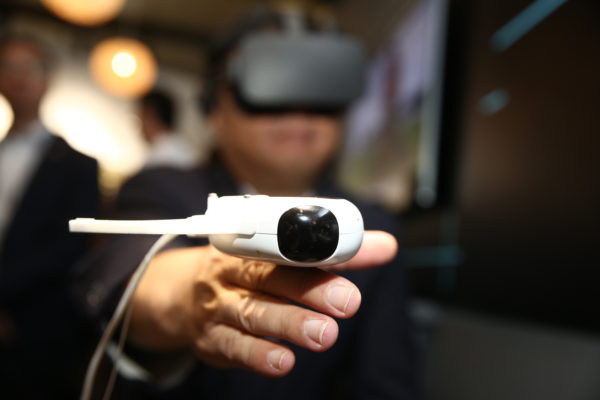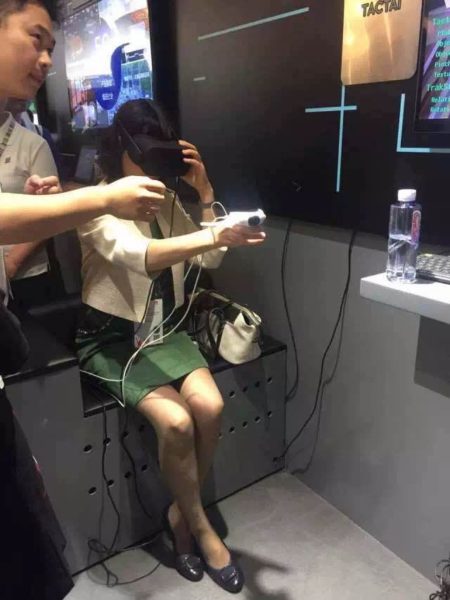
Imagine you are visiting a friend at his or her place to watch a movie together. But, you can do so without stepping out of your house, and even feel the sofa and controls on his or her television console while at it.
This is a future envisioned by Ericsson at their booth at Mobile World Congress Shanghai this year, ahead of the commercial launch of 5th generation (5G) mobile technology scheduled to take place around 2020 in China.
Showcasing the potential uses of its “pre-5G” equipment, the telecom equipment maker is one of several vendors on the event floor demonstrating the new possibilities for businesses through 5G.
Amid the sea of commercial applications (as per recent trends in 5G and wearable computing), I sat down for a mixed reality living room experience that uses a virtual reality (VR) headset, and an intriguing haptic device that was clipped onto my index finger.
(Mostly) surreal
For the visuals, the demonstration employed an Oculus Rift, a lightweight VR headset that can be worn with glasses on (finally) if you are careful. It is more comfortable than the Oculus VR and Microsoft HoloLens for sure.
What is more interesting is the haptic device. Custom-made for the Ericsson showcase by Tactai, a Canadian firm that specialises in haptic solutions for embedded and wearable computing, it comes in various sizes and hooks onto a finger to deliver tactility.
Tactai’s device comprises two actuators to simulate different forms of tactility. The first is a normal actuator motor, like those in a smartphone for its vibration function. It is meant to simulate bumps when one comes in contact with a surface, like a button.
The second is a voice coil actuator that can generate more granular tactility, such as when running your fingers down a granite surface or, in the case of the demo, a soft toy.
Since the Rift does not come with hand tracking functionality like Leap Motion, Tactai also added a Ascension trakStar 3D magnetic location sensor into the mix. Multiple devices can be used to track multiple fingers, though my demo worked with one.
With the kit on, I was seated on a couch in a living room and presented with a TV in front, play controls to the side, and a big, blue teddy bear right beside me.
When I moved my fingers into view of the headset, I could see its movements fluidly rendered within the virtual environment. A tap on the buttons elicited a robust sensation of clicking on an actual button, and the television in front of me came on with a Tudou video.
When I pinched my thumb underneath the haptic device (to simulate a grabbing motion), I was able to pick up a stick, feel it through the haptics, and throw the stick around the room.
As I turned to run my fingers along the “fur” of the teddy bear “beside” me, I could feel the varying textures as I felt my way around its eyes and fur.
Yes, what you feel is all simulated through a device, and the resolution of what you feel is not particularly granular (you can feel the motors moving). Still, it is all quite surreal if you quit being cynical for a minute and just immerse in the experience.
“Future-ready”
While the demo does not yet involve 5G connectivity, Ericsson’s representatives explained this can be expanded in the future, through untethered headsets and haptic devices that support 5G networks.
The bandwidth and low latency that 5G offers make it possible for these shared experiences to be delivered over great physical distances. Both (or more) parties can feel like they are in the same place, interacting with the same virtualised environment.

They can chat (or cuddle, if a full body haptics kit is available) while watching a show, and the video can stop at the same point for all participants in the experience if any of them clicks pause just like in a real room. They can even play Jenga!
The intent here is really to showcase the possibilities companies can imagine and explore with the new technology, according to Ericsson, and this demo is one of the ways to do so.
The Tactai team creates tactility through codes and models that enable the motor to vibrate in a way that simulates the sensation when touching its intended surface.
They have thus been able to recreate these bumps on ordinary powered surfaces like screens, when paired with a stylus with an attached motor. Such is the versatility of this emerging technology.
Ilaan Derche, Tactai’s vice president for product development, said these experiences require very low latency to work well so the audio, video and haptic signals can be in sync and presented without interruption.
This is the kind of use case where high-fidelity transmission technologies like 5G can shine, he added.
The experience I had certainly seems more imaginative than glorified 3D movies of old. I’d look forward to more new ways of socialising in our homes post-2020.






